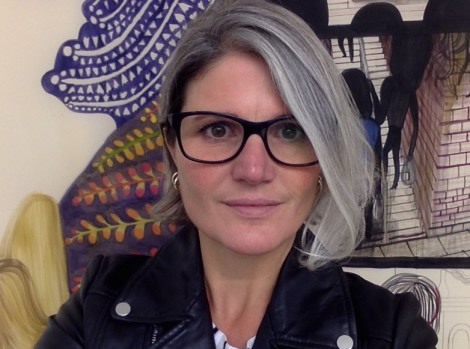Emma Talbot teaches on BA Fine Art as well as being a successful artist in her own right. She recently exhibited in Australia and last month was selected for the prestigious John Moores Painting Prize.
We spoke to her about superstition, her practice, and ‘Finding The Body’ – a recent symposium she organised here at CSM.
Tell us a little bit about your practice in general and what inspires you.
My work is a way of recounting my real life experiences, not just as representational images, but how they are stored and remembered in the complex schema of my mind and psychology. I’m always trying to reveal my stream of consciousness- the kinds of mental images that can’t be recorded through, say, photography or digital means, very directly, through drawing and making.
Does teaching at CSM influence your work in any way?
Indirectly, probably in some way… It’s always really interesting to apply thinking to work that isn’t my own – it’s like I get to think about all sorts of things in depth, that I might not otherwise get to think about. Also, there’s something special about discussing work in progress, when it’s possibilities are still open ended. There’s a great amount of energy and commitment both in the students and the other staff – I guess that encourages me a lot to keep pushing things.
You once said that you’re very superstitious. Does this ever affect your practice? Do you have any rituals within your practice?
[Laughs] I know it’s irrational, but I am – I have loads of “if this happens then that will happen..” thoughts. I think it’s kind of game I play, between deterministic and catastrophic thinking! But no, I don’t apply it to my work. In my work I’m more relaxed – I’ve learned to let go!

© Emma Talbot Me and My Shadow, Acrylic on Canvas, 2011 (210cm x 155cm)
How did the idea for the recent Finding The Body symposium hosted at CSM come about? What can you tell us about the selected speakers and why you chose them?
I thought the work of the ‘Re-Materialising Feminism’ events, that had already taken place at the ICA and The Showroom, really interesting. I wanted to work with Rózsa Farkas, because I like the way she thinks about things, and knew she would bring some really interesting discussions into CSM. So, I proposed that we host something like a ‘Re-Materilising Feminism’ event at the College. ‘Finding The Body’ is what came out of that proposal. We had some great speakers, artists like Hannah Black, Hannah Quinlan and Rosie Hastings and Evan Ifekoya gave presentations of their work and ideas, and Cadence Kinsey, Guilia Smith and Patricia MacCormack gave more academic papers, from very different perspectives. It was a really full and interesting event, loads discussed and loads to go away and think about.
How much would you say your own work redefines the female body?
The images in my work aren’t about an external view of the figure, they are about what it feels like from inside, or from memory. In that respect, I don’t bother following common traits of representation that we see applied to images of women, because I have more to say about the thinking, feeling space of being alive than about those external images.

© Emma Talbot, Memories Turn To Dust, Acrylic on Canvas, 2013 (163cm x 115cm)
Does some use of the body help constitute an artwork as feminist? How have non-male artists shifted what is understood as a representation of the body?
Well, that’s a massive question and something we were trying to address in the symposium. Representation of the body isn’t the hallmark of a feminist work, of course, but the body is the one space we own, and it is interesting to question how it is colonised and appropriated by culture as a means of manipulating our relationship with our own body. The symposium addressed how these questions of body become extended into cultural frameworks.
You’ve just been selected for the John Moores painting Prize. How are you feeling about it?
I’m feeling happy to be included and looking forward to seeing my painting in the show.
Can you tell us about any upcoming projects you’re working on?
Yes, I’m making a lot of 3 dimensional pieces and painting and printing on silk, I’m working towards a one person show at Petra Rinck Galerie, Dusseldorf and my next London show, which will be at Arcadia Missa.
More information:

